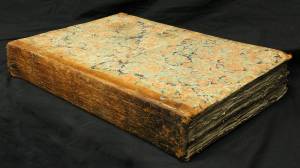Bound Volume of the Daily National Intelligencer
for the Year 1823 |
Click to enlarge:

[DAILY NATIONAL INTELLIGENCER].
Bound Volume, Daily National Intelligencer, Washington, D.C., January 1 to December 31, 1823. Approximately 312 issues, including one 4 pp. The only issues lacking are December 2 and December 3 (the days pertaining to the Monroe Doctrine).
Inventory #22153.02
Price: $4,400
An issue of note, May 30, 1823, reports on the First Intersectional Horse Race, which took place on May 27, 1823. Eclipse represented the North and Henry represented the South. “The third heat won also by eclipse by four lengths- and of course he took the purse of 40,000 dollars. It was a tight race, certainly, and must have afforded the highest degree of interest to those who witnessed it.”
Historical Background
The Daily National Intelligencer was founded as the National Intelligencer and Washington Advertiser by Samuel Harrison Smith in 1800. The paper became the tri-weekly National Intelligencer in 1810 and became the Daily in 1813. In its early years, it served as the voice of the Jefferson, Madison, Monroe, and J. Q. Adams administrations. Its editors, Joseph Gales, Jr., and William W. Seaton, were well known and associated with the National Intelligencer from 1813 until its demise in 1869. The Intelligencer served as the voice of the federal government until the election of Andrew Jackson, when it switched to the Whig party. The Intelligencer was primarily a political newspaper, though it did move sometimes between being “friendly” to administrations and taking a more neutral approach. Like most political newspapers in the partisan press period, the Intelligencer always relied heavily on lucrative Congressional printing contracts for its financial support. The paper was noted for its full coverage of Congress and other government information, including proclamations, notices and advertisements. Seaton and Gales employed shorthand reporters, including themselves occasionally, to take down verbatim reports of Congressional debates and speeches. Because of its depth of political coverage, the Intelligencer was one of the more popular exchange newspapers during the early part of the 19th century. Many other newspapers took their coverage of national politics and government directly from the Intelligencer.
Condition
Original marbleized paper covers and leather spine. Spine in poor condition, separated from many of the bound issues. “Com Ins Co, Salem, Mas” written in ink on the first page of each issue. Bookplates of the Essex Institute on inside of front cover.
Sources
Eighteenth Century Newspapers at the Library of Congress
“National Intelligencer, and Washington Advertiser,” http://www.loc.gov/rr/news/18th/72.html
“National Intelligencer,” http://chroniclingamerica.loc.gov/lccn/sn83026171/
“Daily National Intelligencer,” http://chroniclingamerica.loc.gov/lccn/sn83026172/
http://infotrac.galegroup.com/itw/infomark/1/1/1/purl=rc11_NCNP_2_jn_%22National%20Intelligencer%20%28Washington,%20DC%29%22_AND_rf_Master%20Publication%20Metadata%20Record_AND